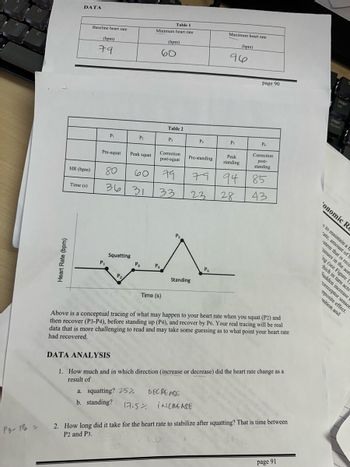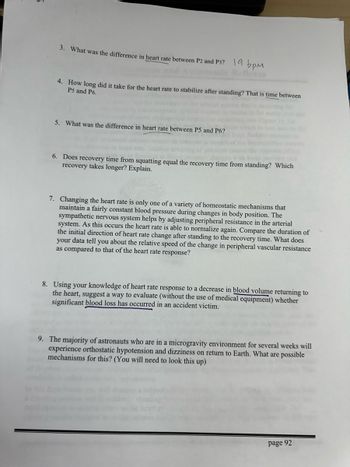
Human Anatomy & Physiology (11th Edition)
11th Edition
ISBN: 9780134580999
Author: Elaine N. Marieb, Katja N. Hoehn
Publisher: PEARSON
expand_more
expand_more
format_list_bulleted
Question

Transcribed Image Text:DATA
Table 1
Baseline heart rate
Minimum heart rate
Maximum heart rate
(bpm)
(bpm)
79
60
Table 2
(bpm)
96
page 90
page
up
Pi
P2
Pj
P4
Ps
P6
Correction
Pre-squat
Peak squat
Correction
post-squat
Pre-standing
Peak
standing
post-
standing
HR (bpm)
80
60
79
79
94 85
Time (s)
3631
33
23
28
43
Squatting
P1
P3
82
This
Time (s)
Standing
P6
page
down
onomic Re
s to maintain a
rate, amount of
'stem that is rece
issues in the aor
ing (see Figure 1
hich in turn acts
Sudden increase
"oreceptor senso
oposite effect.
sition and
Above is a conceptual tracing of what may happen to your heart rate when you squat (P2) and
then recover (P3-P4), before standing up (P4), and recover by P6. Your real tracing will be real
data that is more challenging to read and may take some guessing as to what point your heart rate
had recovered.
DATA ANALYSIS
1. How much and in which direction (increase or decrease) did the heart rate change as a
result of
a. squatting? 25%
b. standing?
DECREME
17.5% INCREASE
2. How long did it take for the heart rate to stabilize after squatting? That is time between
P2 and P3.
P3-1 =
x Tw
page 91

Transcribed Image Text:3. What was the difference in heart rate between P2 and P3? 19 bpM
4. How long did it take for the heart rate to stabilize after standing? That is time between
P5 and P6.
5. What was the difference in heart rate between P5 and P6?
6. Does recovery time from squatting equal the recovery time from standing? Which
recovery takes longer? Explain.
7. Changing the heart rate is only one of a variety of homeostatic mechanisms that
maintain a fairly constant blood pressure during changes in body position. The
sympathetic nervous system helps by adjusting peripheral resistance in the arterial
system. As this occurs the heart rate is able to normalize again. Compare the duration of
the initial direction of heart rate change after standing to the recovery time. What does
your data tell you about the relative speed of the change in peripheral vascular resistance
as compared to that of the heart rate response?
8. Using your knowledge of heart rate response to a decrease in blood volume returning to
the heart, suggest a way to evaluate (without the use of medical equipment) whether
significant blood loss has occurred in an accident victim.
9. The majority of astronauts who are in a microgravity environment for several weeks will
experience orthostatic hypotension and dizziness on return to Earth. What are possible
mechanisms for this? (You will need to look this up)
page 92
Expert Solution
This question has been solved!
Explore an expertly crafted, step-by-step solution for a thorough understanding of key concepts.
Step by stepSolved in 2 steps

Knowledge Booster
Similar questions
- Your female patient is 5'7" and is 20 years of age. Calculate her predicted vital capacity asaparrow_forwardEXERCISE 2. BLOOD PRESSURE AND PULSE ON BIOPAC: Look for the regular vertical 'blips' on the graph as the pressure is released in the cuff. The first vertical 'blip' is systole; to measure, follow the dotted line and read the pressure on the y axis. Write the answer below. Repeat that procedure for the last vertical 'blip', which would correspond with diastole. 210.00 190.00 E 170 170.00 150.00 В 130.00 130 110.00 90 90 00 T0.00 50 30 50 30.00 10 00 -10.00 31.00 1.00 A .00 A. LABEL the that corresponds with the Biopac Recording above: 1. The area above systole 2. The recording that corresponds to systole 3. The recording that corresponds to diastole 4. The area of no blood flow 5. The first pulse after systole B. What is the subject's blood pressure? (systole) mm Hg / mm Hg (diastole )arrow_forwardFill out the missing information completelyarrow_forward
- The bracketing technique is: Question 24 options: a form of velocity training performing techniques at greater than and less than normal resistance a form of acceleration training a combination of all of the above Question 25 Which of the following muscles is NOT a member of the quadriceps: Question 25 options: rectus femoris biceps femoris vastus lateralis vastus intermediusarrow_forwardPlease interpret this 6MWT and what is the recommendation.arrow_forwardWhen the weight is traveling upwards, what type of muscular contraction is taking place at the wrist joint? must watch video clip to answer https://www.youtube.com/watch?v=6pWu4Xko9qM a. Isometric b. Concentric c. Eccentric d. Isotonicarrow_forward
- Poor  posture Assume that your client, Phil, age 55, has come to work out with your facility with poor posture. Now - prescribe a few specific stretching and strengthening exercises for this particular area of concern in addition to some aerobic exercise. Assume your client has been cleared for exercise. 1. State the problem your client has. What will this mean as far as special considerations (what sets this apart from the typical exercise prescription) when Phil exercises? 2. State what stretches and/or strengthening/Resistance exercises you will use. Please attach images and state what the name of the exercise is and what it is supposed to stretch/strengthen related to the procedure, or the condition Phil has.arrow_forwardThe AlterG device uses air pressure to change the effective weight a participant is experiencing True O Falsearrow_forwardContinually training with a specific loading condition that does not vary over time will most likely result in _________________ and little additional improvement.velocity specificty accommodationmuscle action specificityreversibilityarrow_forward
- what is the answer?arrow_forwardDO On the back 26 Treatment of pressure injuries involves proper positioning. What position(s) would you place a patient in to treat a sacral pressure injury? A BO DO Sitting Alternating between prone and side-lying Supine Alternating between supine and sitting earch the web and Windows DELL Activate Windows Go to Settings to activate. Iarrow_forwardExplain how the sex cells produced from meiosis differ from the original cell.arrow_forward
arrow_back_ios
SEE MORE QUESTIONS
arrow_forward_ios
Recommended textbooks for you
 Human Anatomy & Physiology (11th Edition)BiologyISBN:9780134580999Author:Elaine N. Marieb, Katja N. HoehnPublisher:PEARSON
Human Anatomy & Physiology (11th Edition)BiologyISBN:9780134580999Author:Elaine N. Marieb, Katja N. HoehnPublisher:PEARSON Biology 2eBiologyISBN:9781947172517Author:Matthew Douglas, Jung Choi, Mary Ann ClarkPublisher:OpenStax
Biology 2eBiologyISBN:9781947172517Author:Matthew Douglas, Jung Choi, Mary Ann ClarkPublisher:OpenStax Anatomy & PhysiologyBiologyISBN:9781259398629Author:McKinley, Michael P., O'loughlin, Valerie Dean, Bidle, Theresa StouterPublisher:Mcgraw Hill Education,
Anatomy & PhysiologyBiologyISBN:9781259398629Author:McKinley, Michael P., O'loughlin, Valerie Dean, Bidle, Theresa StouterPublisher:Mcgraw Hill Education, Molecular Biology of the Cell (Sixth Edition)BiologyISBN:9780815344322Author:Bruce Alberts, Alexander D. Johnson, Julian Lewis, David Morgan, Martin Raff, Keith Roberts, Peter WalterPublisher:W. W. Norton & Company
Molecular Biology of the Cell (Sixth Edition)BiologyISBN:9780815344322Author:Bruce Alberts, Alexander D. Johnson, Julian Lewis, David Morgan, Martin Raff, Keith Roberts, Peter WalterPublisher:W. W. Norton & Company Laboratory Manual For Human Anatomy & PhysiologyBiologyISBN:9781260159363Author:Martin, Terry R., Prentice-craver, CynthiaPublisher:McGraw-Hill Publishing Co.
Laboratory Manual For Human Anatomy & PhysiologyBiologyISBN:9781260159363Author:Martin, Terry R., Prentice-craver, CynthiaPublisher:McGraw-Hill Publishing Co. Inquiry Into Life (16th Edition)BiologyISBN:9781260231700Author:Sylvia S. Mader, Michael WindelspechtPublisher:McGraw Hill Education
Inquiry Into Life (16th Edition)BiologyISBN:9781260231700Author:Sylvia S. Mader, Michael WindelspechtPublisher:McGraw Hill Education

Human Anatomy & Physiology (11th Edition)
Biology
ISBN:9780134580999
Author:Elaine N. Marieb, Katja N. Hoehn
Publisher:PEARSON

Biology 2e
Biology
ISBN:9781947172517
Author:Matthew Douglas, Jung Choi, Mary Ann Clark
Publisher:OpenStax

Anatomy & Physiology
Biology
ISBN:9781259398629
Author:McKinley, Michael P., O'loughlin, Valerie Dean, Bidle, Theresa Stouter
Publisher:Mcgraw Hill Education,

Molecular Biology of the Cell (Sixth Edition)
Biology
ISBN:9780815344322
Author:Bruce Alberts, Alexander D. Johnson, Julian Lewis, David Morgan, Martin Raff, Keith Roberts, Peter Walter
Publisher:W. W. Norton & Company

Laboratory Manual For Human Anatomy & Physiology
Biology
ISBN:9781260159363
Author:Martin, Terry R., Prentice-craver, Cynthia
Publisher:McGraw-Hill Publishing Co.

Inquiry Into Life (16th Edition)
Biology
ISBN:9781260231700
Author:Sylvia S. Mader, Michael Windelspecht
Publisher:McGraw Hill Education